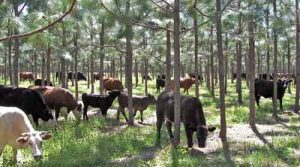… raising livestock and growing trees
.
Interest is growing in a ‘mixed’ type of farming:
Agroforestry: farming in 3D – Vision Group for Sidmouth
Agroforestry: growing not planting trees is the key – Vision Group for Sidmouth
Which is essentially about raising livestock and growing trees:
How farming and forestry could happily co-exist – Vision Group for Sidmouth
.
There is a very particular Iberian landscape:
A dehesa [de’esa] is a multifunctional, agrosylvopastoral system (a type of agroforestry) and cultural landscape of southern and central Spain and southern Portugal; in Portugal, it is known as a montado. Used primarily for grazing, they produce a variety of products, including non-timber forest products such as wild game, mushrooms, honey, cork, and firewood. They are also used to raise the Spanish fighting bull and the Iberian pig. The main tree component is oaks, usually holm (Quercus rotundifolia) and cork (Quercus suber). Dehesa is an anthropogenic system that provides not only a variety of foods, but also wildlife habitat for endangered species such as the Spanish imperial eagle
Dehesa – Wikipedia, la enciclopedia libre
.

This is indeed a type of ‘silvopasture’:
Silvopasture (Latin, silva forest) is the practice of integrating trees, forage, and the grazing of domesticated animals in a mutually beneficial way. It utilizes the principles of managed grazing, and it is one of several distinct forms of agroforestry.
Properly-managed silvopasture can increase overall productivity and long-term income due to the simultaneous production of tree crops, forage, and livestock, and can provide environmental benefits such as carbon sequestration.[3] Silvopasture is one of the oldest known forms of agriculture, and has been practiced in many parts of the world for centuries. Silvopasture is not the same as unmanaged grazing in woodlands, which has many known negative environmental consequences
.
There’s a lot of interest in the United States:
.
And it’s gaining interest in these parts:
Feed trees to sheep to cut greenhouse gases, new study suggests – Devon Live
Defra paves the way for more agroforestry in England – Farmers Weekly
.
And beyond:
Silvopasture: why farming in the forest is gaining popularity | Livestock | capitalpress.com
Young farmers apply ancient agroforestry practices in the heart of Sardinia
6 reasons why the practice of silvopasture will help save modern farming | Greenbiz
Silvopasture: The Benefits of Integrating Livestock and trees – Resilience
There’s More To Silvopasture Than Just Cows And Trees | WisContext
.
photo: Forest Atlas